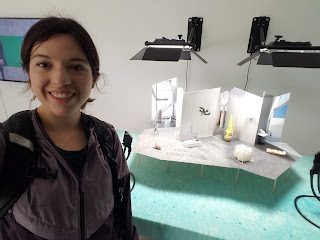Unit 3: Robotics + Art
The use of mechanics and computers has enabled society to establish organized methods for quick, efficient production of products and transfer of information. Robotics has especially had a significant influence in culture for both practical use and artistic pleasure. Machiko Kusahara, a professor at Waseda University, highlights this within her home culture in Japan. One example is Astro Boy, a robotic character featured in manga and animation communities and who encourages fans to view robots as personal friends instead of mindless machines.
 |
| Astro Boy |
Dennis Hong, a professor at UCLA who runs a robotic lab, illustrates how implementing life-like features into a robot can be practical for design. As a Mechanical Engineering student at UCLA, I have noted that many successful robots in the field have been influenced by animals, humans, and nature alike. It would not be so far-fetched to further develop the idea of a robotic friend.
 |
| Dennis Hong Sharing Ice Cream with a Robot |
Robots do not solely come in the form of humans, but in any form in which automation and repetition of tasks is beneficial. Walter Benjamin addresses the growth of such technology in his essay, “The Work of Art in the Age of Mechanical Reproduction." Benjamin argues that this reproducibility diminishes the "aura" of a work of art. The original art piece is not enjoyed the same way when an audience is forced to move quickly with film, machinery, and photographs as opposed to a more still, contemplative experience. Though yes, there is always a difference from copy to copy, Douglas Davis suggest in his essay, "The Work of Art in the Age of Digital Reproduction," that the aura of a work can still be transferred by digital means. Of the two viewpoints, I would agree with Davis that the master and copy are entwined and merging. I can see that an art's aura can be more and more precise as better robots and technologies are developed. Though from my experience, I must acknowledge that some error can exist within the transfer of information and nothing is exactly "like the real thing."
 |
| Example of How Repetitively Reproducing Art Produces Error |
Sources
“Astro Boy.” Character Profile Wikia, characterprofile.wikia.com/wiki/Astro_Boy.
Benjamin, Walter. “The Work of Art in the Age of Mechanical Reproduction.” 1936.
Davis, Douglas. “The Work of Art in the Age of Digital Reproduction (An Evolving Thesis: 1991-1995).” Leonardo, vol. 28, no. 5, 1995, p. 381.
“Dennis Hong- Alchetron, The Free Social Encyclopedia.” Alchetron.com, 18 Jan. 2016, alchetron.com/Dennis-Hong.
Evans, Claire L. “The Work of Art in the Age of Digital Reproduction.” Universe, scienceblogs.com/universe/2010/03/13/in-his-seminal-1991/.
Hong, Dennis. “My Seven Species of Robot -- and How We Created Them.” TED: Ideas Worth Spreading, www.ted.com/talks/dennis_hong_my_seven_species_of_robot.
Vesna, Victoria. “Robotics + Art.” Lecture 2. <https://cole2.uconline.edu/courses/888567/pages/unit-3-view?module_item_id=16300798>.


I really liked your approach to this unit's material. It was very different from mine. I just wanted to add how I've actually heard Professor Dennis Hong speak in UCLA. He was amazing! I remembered how he talked about how robotics is still such a underdeveloped field, and the potential for robots is endless. I hope we all can make robot friends one day haha!
ReplyDeleteI agree with your viewpoint in agreeing with Davis's perspective. I think it is really interesting how he and you both admit that copies can never be exactly like the real thing through replication, which is sort of contrary to mainstream belief in faith transmission of art.
ReplyDelete